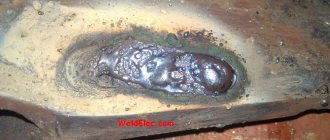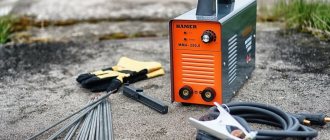The importance of calcining materials before performing welding work has been proven by many professionals. The lack of heat treatment affects the quality both during welding and after. Poor ignition and sticking of the rod, shedding of the coating, unreliability and defectiveness of the welded joint, unsatisfactory appearance of the finished product (in the photo on the right: bubbly slag from the wet coating) - and these are just the main problems.
When is drying done?
If the electrodes have been stored in a warehouse for more than 3 months, they must be dried, even if visual inspection does not reveal obvious signs of high humidity. The same applies to electrodes that have been stored for more than five days without sealed packaging. Their technical characteristics deteriorate, creating an uneven arc and improper heating of the metal, which results in a poor-quality weld. Therefore, there are clear storage rules for electrodes, as well as parameters for calcination and drying in a cabinet, oven or pencil case.
Damp electrodes lead to weld defects:
- pores form;
- fistulas may occur;
- cracks form;
- The electrode often sticks.
If the welding seam is of poor quality, or problems arise with the electrode sticking or arc ignition, then first of all it is necessary to dry the electrodes. This will not only give a high-quality seam, but also reduce the consumption of electrodes. It is not always possible to store electrodes in ideal conditions. At large construction sites or enterprises, they are purchased in large quantities and stored for quite a long time. At home, electrodes also deteriorate due to long-term storage in the garage, basement or country house.
MEZ electrodes
All technological parameters of heat treatment of electrode products: temperature conditions, holding time, etc., are indicated by the manufacturer on the packaging and in the accompanying documentation. The products of the Magnitogorsk Electrode Plant are no exception. You will find this and other data on the MEZ branded packaging, as well as in the documents.
The high quality of electrodes of this brand is confirmed by certificates of the Russian river and sea registers, as well as GOST and NAKS certificates.
How is drying done?
The temperature and holding time are different for different electrodes, so before you start drying, carefully study the packaging. Foreign manufacturers do not always indicate drying parameters on their boxes; to find them out, you need to go to the manufacturer’s website, where more detailed technical specifications are posted. Since cellulose electrodes must have the lowest moisture content in the coating during operation, they are packaged in metal cans and it is not recommended to calcinate this type of electrodes. In practice, they can be calcined at a temperature no higher than 70 degrees, otherwise the coating will collapse.
Special devices have been developed for this:
- bake;
- closet;
- pencil case.
In addition, there are “folk” methods - how to dry electrodes without the use of special equipment. It is recommended to carry out calcination and drying no more than 3 times. Practice has shown that with a greater number of calcinations, the coating crumbles and crumbles.
Drying and baking are not the same thing
Calcination of electrodes is carried out strictly according to the instructions, and nothing else. A heating battery cannot replace calcination, on which many people place electrodes in winter to dry them. The main purpose of drying electrodes is to remove moisture from the coating.
However, on heating radiators, it is, alas, impossible to achieve complete calcination of the electrodes. For these purposes, special furnaces are used in which the electrodes undergo heat treatment. As for home conditions, methods for calcining electrodes, in this case, will be discussed below.
Stationary ovens for drying electrodes
In stationary conditions, an electric heating furnace is used. This is a metal cabinet with special trays for electrodes. To maintain a given temperature, all walls in it are lined with heat-insulating materials. It is equipped with a thermostat for medium temperatures ranging from 60 to 500 degrees in order to carry out drying in strict accordance with the manufacturer’s requirements. This ensures even heating and temperature retention throughout the entire process. Depending on the size and number of trays, the oven can be designed to simultaneously load batches weighing from 10 to 250 kg.
The drying process is very simple - the electrodes are placed inside the oven for the required time. The heating temperature is regulated and maintained automatically. New models have a timer that will turn off the oven after a strictly specified time. Due to thermal insulation, the cooling process occurs evenly. After this, the electrodes are ready for use.
Design and functionality
The case for calcining electrodes has a rectangular shape. The dimensions depend on the volume of the electrodes to be accommodated; for household devices it is approximately 150x170x600 mm. The pencil case consists of:
- frame;
- camera;
- a heating element;
- electrical insulation;
- thermal insulation;
- front cover for loading the camera;
- back cover and heating control unit;
- wires.
Before drying the calcined electrodes, they are placed in the chamber and tightly closed with a lid. Then, on the reverse side, the wires are connected to the power source. The heating element is turned on - a spiral wrapping around the outside of the chamber.
The chamber is first covered with insulation, only then the spiral is laid so that the current does not flow when touching the electrodes and the inner surface of the thermal canister.
The heating element raises the temperature inside the device to 110⁰C. This is enough for the moisture to evaporate. After 2 hours you can start working.
In a home workshop, with a small amount of welding work, they use covers for electrodes that have a plastic sealed housing . They retain the heat of hot objects placed inside and do not let air through. The coated rods cool for several hours, remaining hermetically sealed.
Cases thermoses and thermal cases
It often happens that welding work is carried out outdoors or in conditions of high humidity, so the electrodes can quickly become damp and become unusable again. Pencil cases are specially designed for such cases. They are sealed and thermally insulated, allowing the electrodes to remain dry for a long time. According to their design, thermos and thermal pencil cases are distinguished.
Thermos cases are small in size and have a heat-insulating inner coating. They are especially convenient for storing already dried electrodes at construction sites in any weather and time. The electrode drying case is equipped with heating elements, a thermostat and allows drying right on the spot. It is small in size and can dry about 10 kilograms of electrodes at a time. Thermal canisters have two types of connection - to a socket and to a welding transformer.
Drying equipment makes it possible to obtain different temperature conditions and precise time control, allowing you to calcinate electrodes of various brands and manufacturers. It restores the working properties of the electrodes, speeds up the work of the welder and saves money on the purchase of new electrodes. Drying the electrodes is much faster and easier than redoing a poor-quality weld later.
Calcination of welding electrodes: what equipment will cope with the task
Even if you want to dry the electrodes at home, there is special equipment for this. Let's figure out what it is like and what its features are.
- An electric furnace with the ability to calcinate electrodes with a built-in thermostat. This is a compact equipment that is easy to transport and move from one place to another. Up to 50 kg of electrodes can be placed in a mobile electric furnace. Most often, such models are equipped with automated controls, which makes working with them easier. Standard 220 V will be enough to start the oven and dry the conductors. Models differ in power level.
- Electric oven with drying function. Modern equipment models have a microprocessor, thanks to which the process becomes automated. Thermal insulating electric furnaces provide uniform heating, which is important for complying with the rules for drying the electrode. In a conventional oven, you cannot dry the conductors precisely because it is impossible to ensure uniform temperature exposure and control the temperature. The maximum power of such electric furnaces is 8.5 kg. The conductors heat up to 400 degrees, no more is needed.
- Special case for drying electrodes. It is a sealed container that maintains a certain temperature. The thermal pencil case is easy to use due to its compact size. It differs in the specificity of heating the electrode due to the energy of the transformer. Online electrode drying is also available. The disadvantage of a thermal case is the maximum volume of electrodes – up to 10 kg. For home use, this is the optimal method of piercing.
How to dry electrodes at home
The main purpose of calcination is to reduce the percentage of moisture in the coating of welding electrodes, while the structure does not change in any way. To dry the electrodes you do not need any special skills or knowledge. Just look at the packaging for the temperature and time of the process. On average, it is recommended to carry out the procedure at a temperature of 220 - 250 degrees for 1.5 - 2 hours.
To do this, you can use any heating device that you have at home. An electric oven or gas oven is perfect. An electric oven is more suitable for drying than a gas oven, since the gas contains a certain amount of water and in no case should it be heated over an open fire. The quality of this method cannot be compared with the result using a professional cabinet or pencil case.
In this situation, the worst decision would be not to calcinate the electrodes at all. This will lead to increased consumption of materials, poor-quality seams, and loss of time, and in the worst case scenario, redoing the entire job.
At what temperature should the electrodes be annealed?
It all depends on the type of electrode and the type of coating.
- With rutile coating, general purpose (E-38, E42, E-46) – 150... 270 °C for 1–1.5 hours.
- With basic coating, general purpose (E42A, E-46A, E50 and others) – 300... 450 °C for 1-2 hours.
- With acid coating – 185… 190 °C, 1 hour.
- With cellulose coating – 155... 160 °C, 15 minutes.
- Special purpose – 300… 450 °C, 1–2 hours.
For clarity, using the example of the most famous brands, we will show how and how much to calcinate the electrodes in the form of a table.
| Brand | Calcination temperature (+/- 20 °C) | Exposure time, h. |
| UONI-13/45 | 400°С | 3 |
| UONI-13/55 | 465°С | 3 |
| ANO-4 | 200°C | 2 |
| ANO-9 | 360°C | 2 |
| OZS-6 | 200°C | 2 |
| OZS-12 | 200°C | 2 |
| MR-3 | 200°C | 2 |
| TsU-7 | 360°C | 2 |
| NZh-13 | 250°С | 1 |
| TsL-17 | 380°C | 2 |
| OZL-7 | 250°С | 1 |
Features of the process implementation
All the secrets of preparing electrodes for welding lie in the correct calcination procedure. Typically the process is carried out in several stages:
- Consumables are placed inside the device or for special occasions. The machine or oven closes.
- The temperature rises. Usually the characteristic is written directly on the packaging, set by the manufacturer;
- Turn on the oven and wait for the desired interval. The consumable material must cool down, after which it can be removed for direct use.
The procedure obliges the specialist to comply with safety requirements. Actions must be performed in a special uniform and using other personal protective equipment.
Bottom line
Proper preparation for welding is the key to its reliable and high-quality work. This also applies to electrodes that need to be dried and calcined, especially when welding critical metal structures or obtaining sealed seams.
At the same time, do not forget how many times you can heat treat them, because it is not recommended to anneal the electrodes more than twice. This is due to the fact that the electrode coating may deteriorate and the rods will become unusable.
Sources
- https://met-lit.ru/raboty-s-metallami/prokalivanie-elektrodov.html
- https://art-stal.ru/instrumenty/prokalka-svarochnyh-elektrodov.html
- https://instanko.ru/osnastka/sushilka-dlya-elektrodov.html
- https://spark-welding.ru/instrumenty-i-oborudovanie/kak-prokalit-svarochnye-elektrody.html
- https://titan-spec.ru/stanki-i-instrumenty/prokalivanie-elektrodov.html
- https://rezkamet.ru/prokalka-elektrodov-v-domashnih-usloviyah/
- https://cs-important.ru/tehnika/kak-prokalit-elektrody-v-domashnih-usloviyah-kak-sushit-v-duhovke-fenom-svoimi-rukami.html
- https://ometalledo.ru/prokalivanie-elektrodov-pered-svarkoj.html
- https://uniform-met.ru/articles/layfkhak-dlya-svarshchika-kak-prosushit-elektrody-v-domashnikh-usloviyakh/
- https://magelectrod.ru/article/prokalka-elektrodov-zachem-ona-nuzhna/
Drying and calcination - differences and features
In addition to calcination, there is such a thing as drying electrodes. It means the direct preparation of the product for work. In turn, calcination of the electrodes is performed to eliminate excess moisture and eliminate the consequences of improper or long-term storage.
Drying involves reducing the moisture level in the rods to a minimum acceptable level. It is produced at low temperatures and does not have a serious effect on the coating.
Calcination can be performed to improve the quality of the electrodes and bring them into “working condition”. The peculiarity of this procedure is the long exposure time and high temperature.
Please note that experts do not recommend calcining the electrodes more than 2 times. The coating can break off from the core and they will become unusable.
How many times can electrodes be calcined?
As mentioned above, the electrodes are calcined several times. There is no need to anneal each time before welding. Speaking specifically about quantity, it is not recommended to cook electrodes more than three times.
You should be aware that the electrodes have already been calcined at the factory before packaging, so if the electrodes have just been purchased, they usually do not require calcination and are completely ready to use. Also, do not prepare all the electrodes at once. In any case, if you fail to develop them, you will have to do the calcination again.
Therefore, it is enough to take the required number of electrodes for work, after which they are calcined and used. How to calculate how many electrodes are in a package was already described earlier on the site about manual arc welding.
Proper storage
To prevent the formation of excess moisture in the electrodes, they should be stored correctly. Factory-made shrink film cannot always protect products, especially during long-term storage.
The first thing you need to remember is the temperature in the room where the rods are located. The warehouse or utility room should not be colder than 15°C. Room temperature will be enough to prevent them from getting damp. Also avoid large temperature changes. This may cause condensation to form inside the packages.
Another important point is the humidity level. It should be minimal. Otherwise, the electrodes will pick up moisture very quickly. Drying may not help and you will have to spend a lot of time calcining.
Take special care to protect the electrodes from mechanical influences. Damage or chipping of the coating impairs welding properties.
Following these simple rules will extend the shelf life of the electrodes. They will retain their qualities, and you will be able to make high-quality and reliable connections.
What is Calcination?
calcination
— CARINE, liu, only; linen (yon, ena); Sov., that. Subject to strong heat. Ozhegov's explanatory dictionary.
Interesting materials:
How to connect a laptop to the Internet via wifi? How to connect a laptop to a computer monitor? How to connect a laptop to a printer via a network? How to connect a laptop to a TV via HDMI RCA? How to connect a Lenovo laptop to Wifi? How to connect a new washing machine? How to connect a new key fob to a tomahawk alarm? How to connect a new remote to Apple TV 4? How to connect a new remote control to a Samsung TV? How to connect both Elari headphones?










